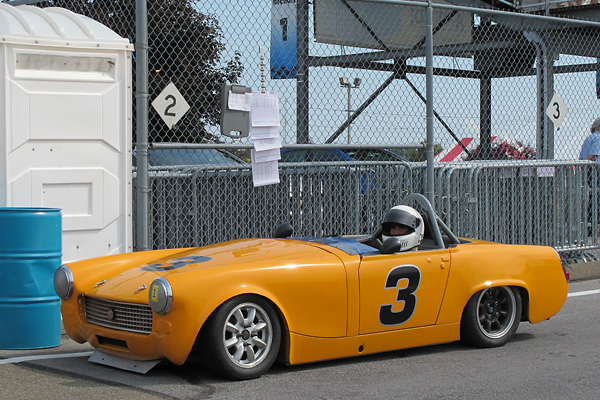
Rick Haynes' 1965 MG Midget Vintage Racecar
Owner: Rick Haynes
City: Hebron, Ohio
Model: 1965 MG Midget
Engine: BMC A-Series 1275cc
Prepared by: owner
BritishRacecar Interviews Rick Haynes
Q: Rick, how long have you owned your MG Midget?
A: The orange one here? I built it... two years ago. (~2010)
Q: Was it a racecar at all when you started?
A: No, it was a bare tub that I found in a garage in Gettysburg PA.
Q: And this racecar was never meant for SCCA; it's strictly a "vintage" car?
A: Yes. It was built so I'd have something to do now that SCCA has lost interest in all the older cars.
Q: It's probably about as low as anyone gets a vintage car?
A: Well, that's one of the things you want to do with a racecar... one of the primary things to accomplish.
Q: So one of the first things to do was route the exhaust through the tunnel. Did you make your own headers?
A: I do everything on these cars except the heads. The heads are done by George Bachmann of Midwest Motorsports
in Toledo. I fabricate headers, build carburetors, build the motors, design all the pieces... that's sort of
what I do in my business.
Q: What other parts should I point out to people?
A: Well, I build all the important parts to build a Midget because I like the quality of my own stuff better
than what I can buy. So, I make the hubs and the axles - the front hubs and the double-bearing rear hubs - the
exhaust systems, the carburetors, the camshafts, the pistons, basically all the essential pieces.
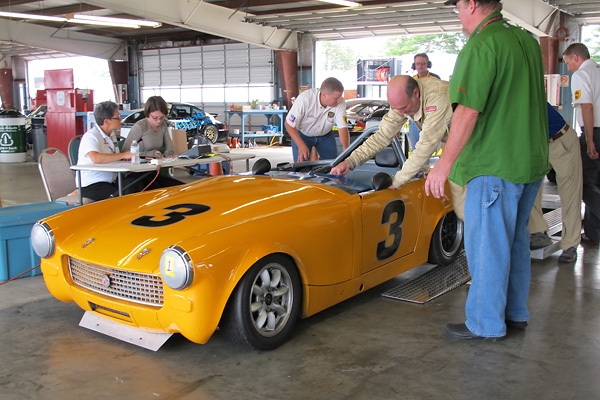
Coming off the scales after winning his race. 1275cc Spridgets are required to weigh at least 1470#,
plus 20# if "no headlights", plus 25# if "no charging system", plus 20# if "removal of passenger seat".
Q: And the suspension geometry is special?
A: Probably not special in the respect that it certainly isn't anything but fairly traditional stuff, but
it's got stuff in it that I've found during the years worked pretty good, but it's probably not that much
different than other peoples'. There's only certain perimeters that you can do in a suspension, and
everyone has got to pretty much adhere to that.
Q: On an MGB, I know people are doing dropped spindles to raise the roll centers. It that a similar game
on a Spridget?
A: Anytime you drop a car down, you've got to take into account what you've done to the roll centers and
you've got to make the adjustments accordingly.
Q: Are those steel fenders? They have to be for vintage don't they?
A: Yes. The rules say "no flares" and everything has to be steel, but with the economics of running a race
they're more interested in the entry fee than they are with adhering to the rules, and they're getting pretty
flexible with that stuff, and I noticed in the five or six years prior to building the car myself - just
going to the vintage races - it was pretty clear that they had sort of become very flexible in that area
so I built it with a little bit of a flare front and rear just to keep up with everybody else.
Q: So the flare... this part is glass?
A: No. Everything you can feel with your hand (underneath) is steel. There's just a little bit of Bondo to
contour it out. But everything you can feel is steel. Same at the back.
Q: And the chin spoiler? That's to the vintage rules?
A: Well, you know, I kept expecting someone to say something about that. The way I understand the rules is
that anything that was legal prior to 1972 is legal, and I've got photos and documentation that shows they
were running spoilers prior to that. I'm just sort of waiting for somebody to come up and say I can't run
it. I haven't needed to pull out all my stuff yet!
Q: The windscreen is about as low as it could possibly be.
A: Yes. I try to sit as low in the car as I can, and there's no reason...
Q: You're wearing a visor anyway.
A: That's right. I just put a little thing to deflect the air a little bit.
Q: You're not allowed to run a dry sump?
A: That's right. I run an Accusump, and an oil pan of my own design.
Q: Is there anything from Winners Circle or Huffaker on the car?
A: Oh God no! I wouldn't put a Winners Circle or Huffaker made part on my car. I think all the parts I
have are better than theirs. And I have no reason to... you know. I've been doing this long enough that
I know what all the faults and all the advantages are, so I build them or I have them built to my own
specifications. Well... the one thing that might be considered a Huffaker part is the seat in this car.
It came out of the Jon Woodner Midget that he totaled in Atlanta at the 1971 runoffs.¹ He stuck it in a
barrier. Sold the car to Bill Koch in 1972, and I bought the seat off of him. I've used that seat in a lot
of cars.
Q: Tell me about the rear.
A: Well, that's pretty traditional. They've been using three link slipper rears - or slipper rears with
one design or another - way back into the sixties with Trans Am cars. Oh, what's his name. Bud Moore.
Bud Moore did slipper rear ends for the Mustangs and Cougers. It's an adaptation so that you can use a
leaf spring without any of the disadvantages. It's fairly complicated to build, but once you get it right
it's almost as good as a coilover. Not quite, but almost as good as a coilover. Huffaker did them for
their cars. In fact, it's probably designed pretty close to what Huffaker put in the Midgets and it's
probably pretty close to what Joe put in his Midget because it's a fairly traditional design that everyone
knows about.
Q: Watts link for side-to-side?
A: Yes, Watts link plus single link in the top and two lower links on either side below the springs.
Q: And the springs are gullwing springs? Do you need that on a vintage car?
A: I wasn't sure if you did or not, but since I knew the specification of the gullwing springs and I
had to do something anyway I decided to do them that way.
IMPORTANT ANNOUNCEMENT
BritishRaceCar.com will have to cut back plans for continued growth if we can't find more financial support.
If you like what you've found here, and you want to see more, please click here and follow the instructions.
Readers like you keep BritishRaceCar.com online and growing through voluntary financial contributions.
Q: How do you make a gullwing spring? Do you cut a wider spring?
A: Yeah, you take a 3" piece of spring steel and you cut it out. And then you take it to the spring
shop and have the ends rolled on it, have it tempered and arched, and you hope you got it right.
Q: And the differential. Is it welded?
A: Yes, it's a welded "4.2".
Q: Do you change the ratio for different tracks?
A: For the most part, the 4.2 seems to be good everywhere. If I went to Road America I might consider
putting a 3.9 in it. Plus it's complicated. You might have to change your gearbox ratios, and that's
more trouble than its worth.
Q: I didn't see which shocks you run...
A: You can run tube shocks in the back, but you have to keep lever shocks in the front. They're
Armstrong lever shocks in the front and then tube shocks in the back.
Q: In the front, are those Peter Caldwell (World Wide Imports, modified) adjustable shocks?
A: No, they're something I did myself.
Q: And the gearbox?
A: A gearbox I built. It's basically a copy of what everyone else runs. It uses Mk9 Webster (Hewland)
gears. When Todd Wheeler started making them in the early eighties they were sort of a unique thing.
Then Todd stopped making them for whatever reason. I needed a couple of gearboxes, so I started building
them myself. All the pieces in them were made by Webster. Unfortunately, Webster is out of business,
so you can't do that anymore. And the gearbox is basically a re-engineered gearbox of what Wheeler did.
Richmond took apart a Wheeler box and he built an improved version of the box with a lot of high-buck
stuff. Then when Richmond stopped, Taylor took a Richmond box and basically copied that. Of all the
copies out there, in fact, the Richmond and Taylor are closest to identical. I think they have a lot
of parts that swap out. But I don't like to pay people money for stuff I can do myself and I can build
a gearbox as well as anybody else. This gearbox is twenty years old.
Q: What else should I know about?
A: The orange is the same color as my first SCCA car. Except, the orange I had then was Rust-Oleum
"Omaha Orange" out of a spray can and this one is '70 Mustang "Grabber Orange". This is what the
Trans Am color is. Actually, they say this is what the color was in 1970, but I think it's a little
brighter. It's what Ford used about five years ago on their Boss 302.²
Features and Specifications
| Engine: | 1275cc BMC A-Series engine with 0.020" overbore.
Billet crankshaft.
Venolia forged pistons.
Carillo connecting rods.
Sports & Imports camshaft.
Midwest Motorsports modified cylinder head.
Titan roller rockers (1.5:1 ratio.)
Iskendarian lifters, valve springs and retainers.
Iskenderian chrome-moly tubular pushrods (8.437" long, part# SP-003).
Sports & Imports modified dual S.U. HS4 (1.5") carburetors.
Mallory Unilite distributor.
Jeg's 8mm Power Wire spark plug wires.
NGK spark plugs.
MSD Blaster 2 ignition coil.
MSD 6AL capacitive discharge ignition box (part# 6420).
Modified Datsun 240Z gear reduction starter.
Sports & Imports wet sump oil pan (external pickup plumbing).
Accusump oil accumulator, with electric solenoid valve.
Fram Racing HP11 engine oil filter, remotely mounted. |
| Cooling: | Sports & Imports copper and brass crossflow radiator.
Custom fabricated aluminum header tank.
Modified water pump.
Oil cooler. |
| Exhaust: | Sports & Imports long-center-branch 3-into-1 header.
Through-the-tunnel exhaust system.
Sports & Imports megaphone style exhaust tip. |
| Transmission: | Sports & Imports rib-case 4-speed dog-ring gearbox.
Lightweight flywheel.
Tilton 7.25" single disc clutch.
Girling 0.625" master cylinder. |
| Rear Axle: | straightened Spridget axle housing.
Sports & Imports two piece competition axle shafts.
Sports & Imports double bearing hubs.
Welded differential.
4.2:1 ring and pinion. |
| Front Susp.: | Sports & Imports aluminum front hubs.
? coil springs.
Modified Armstrong lever shock absorbers.
Sports & Imports modified lower control arms and kingpins.
Steering arms modified to reduce bump steer.
3/4" tubular anti-sway bar, mounted on aluminum pillow blocks. |
| Rear Susp.: | Sports & Imports prepared "slipper" three link.
(Axle is located by one radius rod above the pinion and two below the leafsprings.)
Gullwing semi-elliptic leaf springs.
Carrera telescoping shock absorbers.
Adjustable anti-sway bar.
Watts linkage (with pivot mounted on chassis). |
| Brakes: | (master) Sports & Imports modified pedal assembly. Dual master cylinders
(Wilwood 0.625" front, Girling 0.700" rear.) Allstar Performance remote bias adjuster. (front) stock 8.3" rotors and calipers. Hawk "blue" brake pads. (rear) stock 7" drum brakes. |
| Wheels/Tires: | Panasport Racing 13x6 aluminum wheels (front).
Western 13x6 aluminum wheels (rear).
Hoosier Street T.D. *S P185/60D13 racing tires. |
| Instruments: | (left to right)
Jones / Moroso mechanical tachometer (1000-11,000rpm),
AutoMeter Sport-Comp oil pressure gauge (0-100 psi),
Westech dual pyrometer (700-1700F),
Stewart Warner oil temperature (140-325F),
AutoMeter fuel pressure (0-15psi), and
AutoMeter Sport-Comp coolant temperature (120-240F) guages. |
| Fuel System: | Jaz Products Pro Sport fuel cell with D-ring cap.
Dual Facet (Bendix style) fuel pumps.
Fram HPG1 fuel filter.
|
| Safety Eqpmt: | Sports & Imports rollcage.
G-Force Racing Products Pro Series 5-point cam-lock safety harness (with Pyrotech pads).
Low-back fiberglass racing seat.
Lecarra steering wheel mounted on a quick release hub.
Vitaloni "Sebring" mirrors.
Phoenix Halon fire suppression system.
Attwood Sea Guard marine battery box.
Pollak battery disconnect switch. |
| Racing Class: | SVRA Group 1, F-Production |
Engine Installation
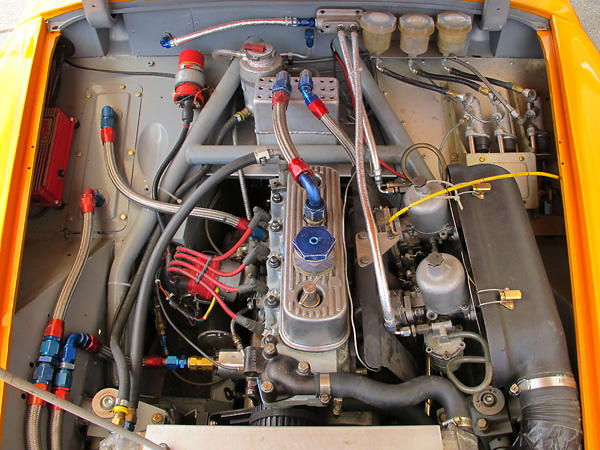
1275cc BMC A-Series engine with 0.020" overbore.
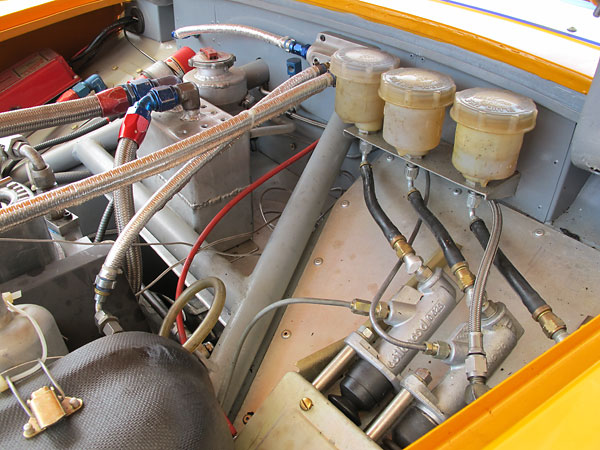
The remote reservoirs are marked: "Use Only Castrol Girling Fluid".
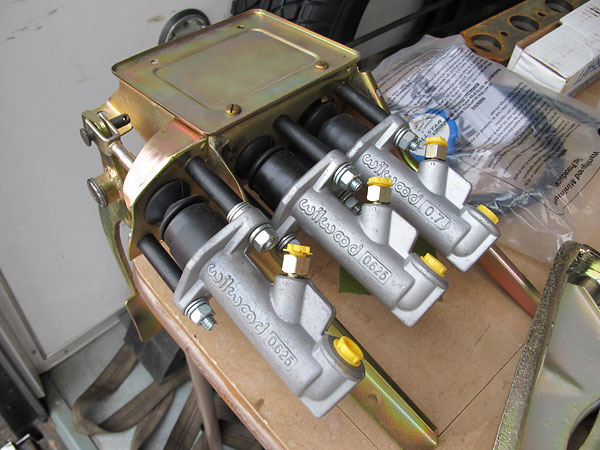
Sports & Imports modified Spridget pedal assembly.
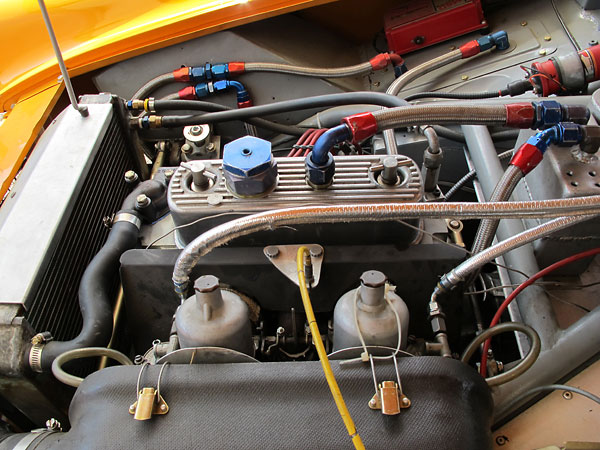
George Bachmann at Midwest Motorsports ports Rick's cylinder heads.
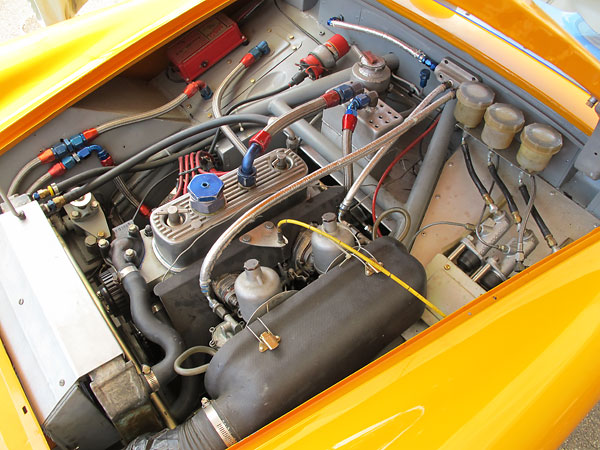
Engines run better and make more power from cooler air.
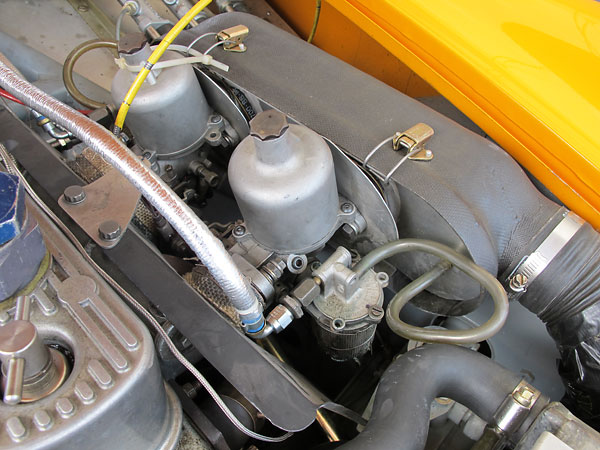
Sports & Imports modified dual S.U. HS4 (1.5") carburetors.
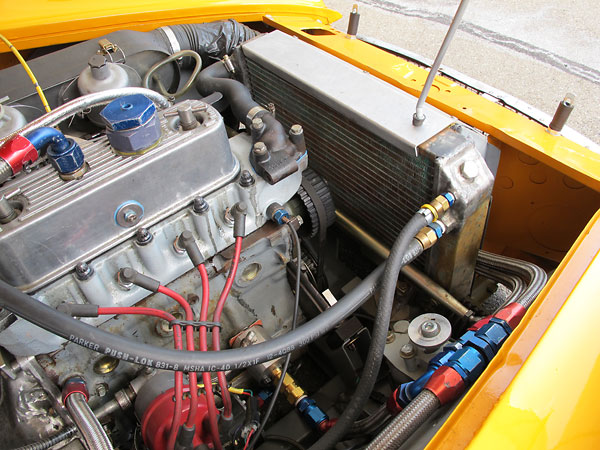
Sports & Imports copper and brass crossflow radiator.
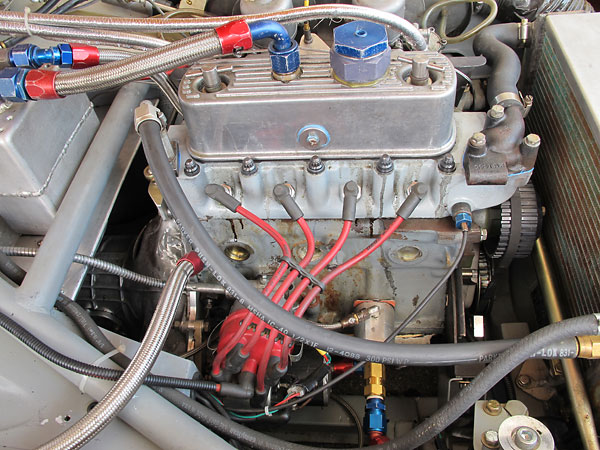
Mallory Unilite distributor and Jeg's 8mm Power Wire spark plug wires.
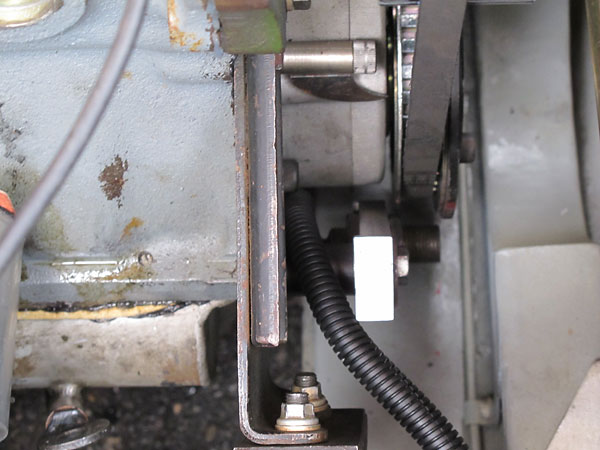
Top of frame: a nifty pointer to aim your dial-back timing light at. Center: a Hall effect
sensor has been positioned to detect crankshaft speed, but apparently it senses just one
tooth once per revolution. (In this view, we can't see any teeth on the trigger wheel.)
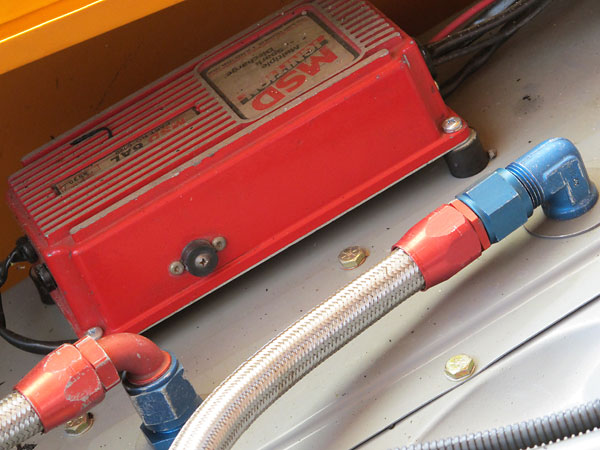
MSD (Multiple Spark Discharge) model 6AL ignition box. Note: the 6AL
model includes a rev-limiter, but Rick doesn't use that feature.
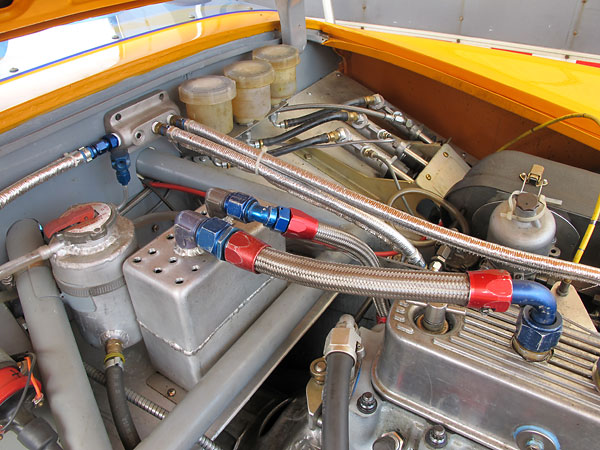
Custom fabricated aluminum coolant header and crankcase breather tanks.
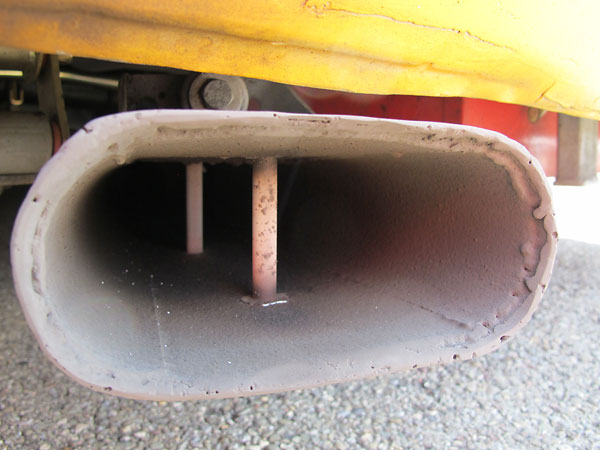
Megaphone style exhaust tip.
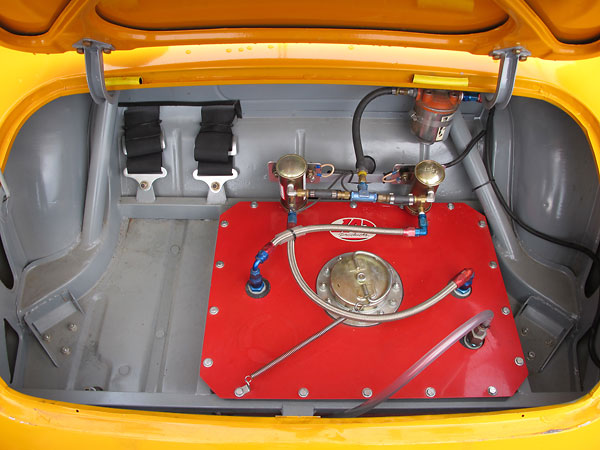
Jaz Products Pro Sport fuel cell with D-ring cap and breather.
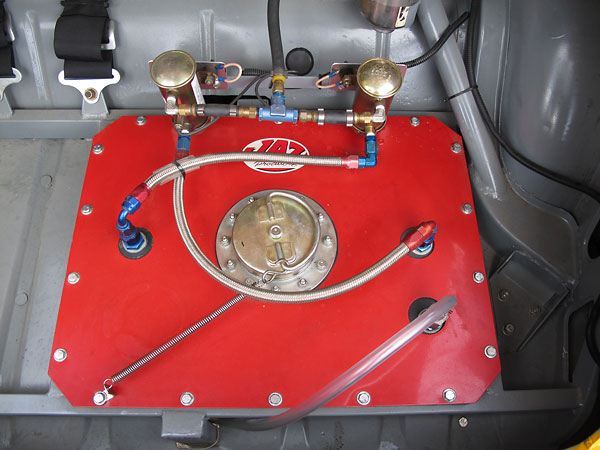
Dual Facet (Bendix style) fuel pumps. Fram HPG1 fuel filter.
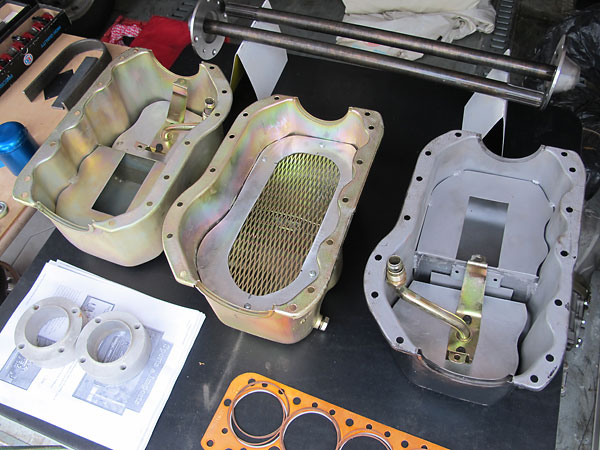
Two styles of Sports & Imports wet sump oil pans. The pan in the center
(with external pickup port) is similar to what Rick uses on his own car.
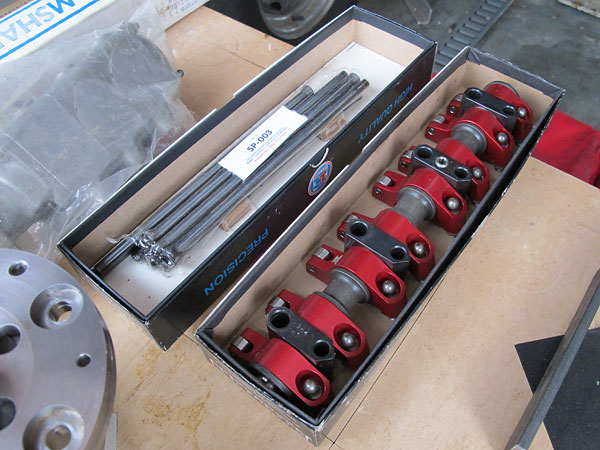
Titan roller rockers (1.5:1 ratio.) Isky chrome-moly tubular pushrods (8.437" long, part# SP-003).
Front Suspension / Etc.
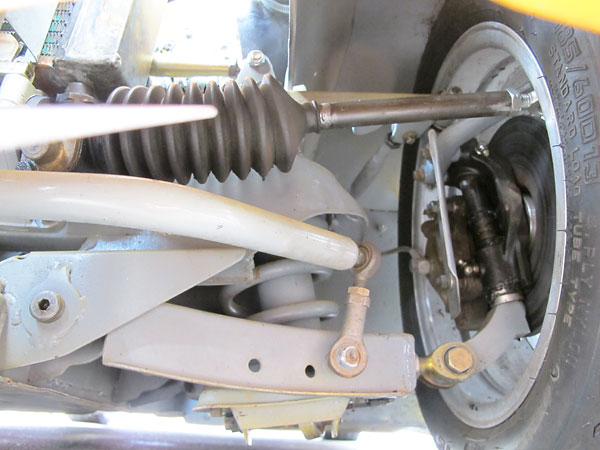
Modified upper and lower control arms. Normally, a Spridget's upper control arm is a single link
that's integral to the lever shock absorber. Here, a supplemental link extends rearward.
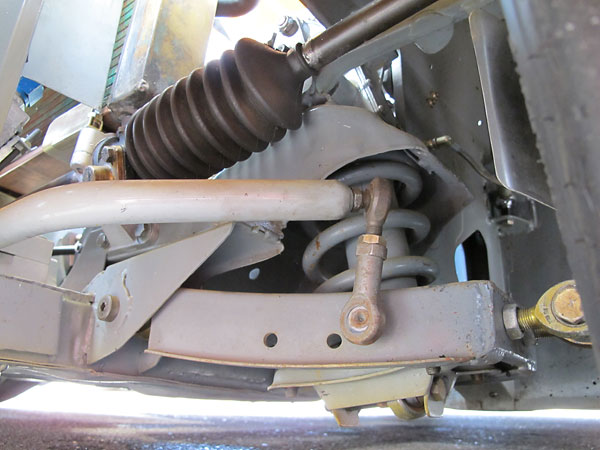
A theoretical advantage of lever shock absorbers over telescoping shocks is they don't add
unsprung weight. In practice, most racers prefer tuning telescoping shocks.
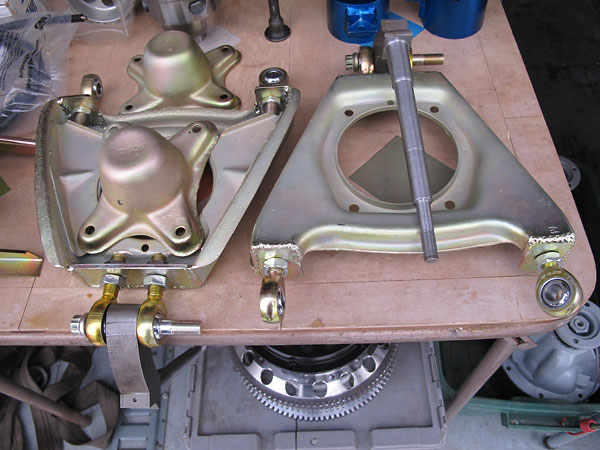
Billet steel kingpins.
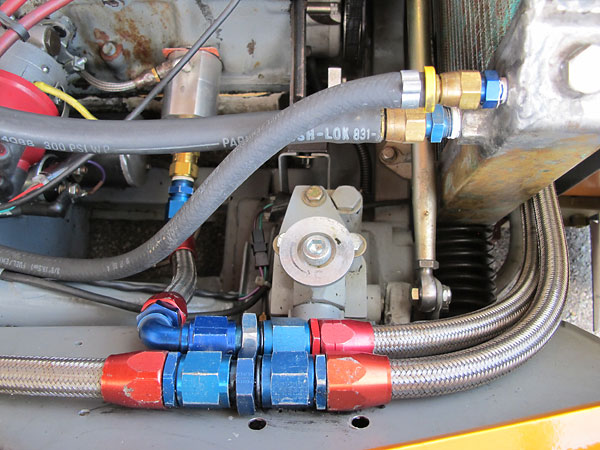
A swaged Monte Carlo bar stiffens the front suspension mounting areas.
Profiting from this article? Not us! Please help us cover travel and web hosting expenses.
To toss some change in our tip jar, please click here. Doing your part is quick and easy.
We also offer targeted, cost effective advertising options. Please click here to learn more.
Rear Suspension
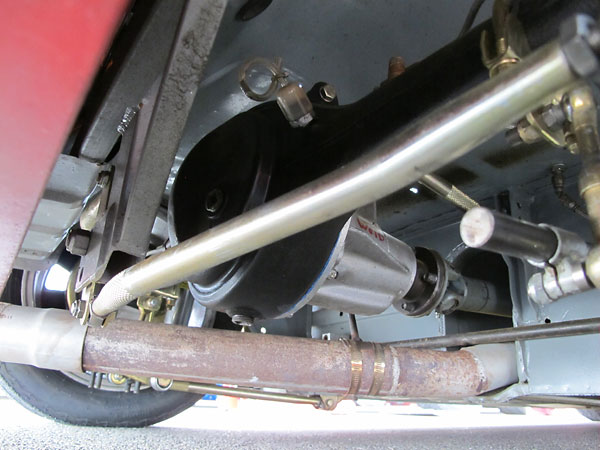
Straightened axle housing for a welded differential and 4.2:1 gears.
A Watts linkage keeps the axle centered, relative to the body.
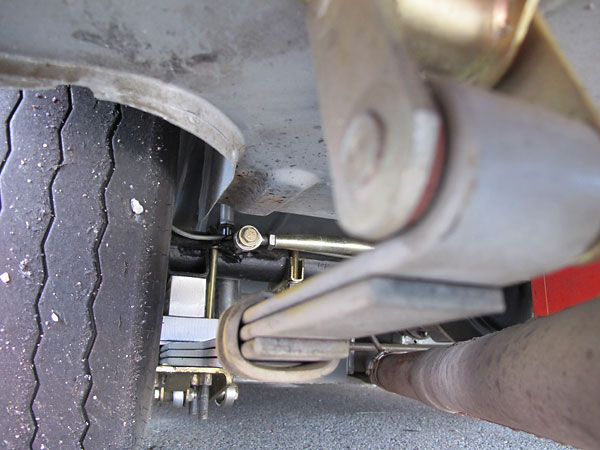
Gullwing springs were developed to provide clearance for the very wide
racing slick tires used on MG Midget racecars in the 1970s.
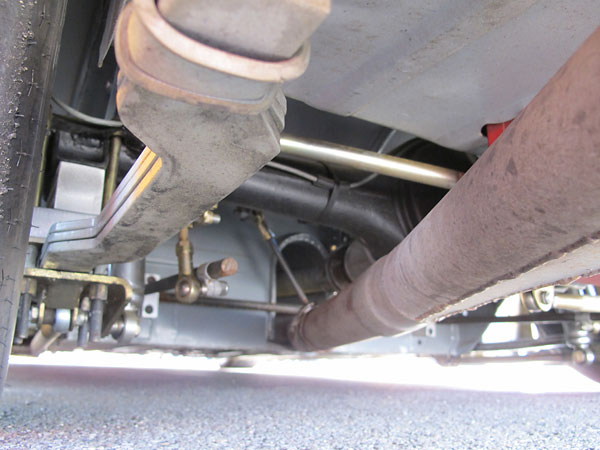
This is a slipper style three-link rear suspension: spacers prevent the U-bolts from
clamping to the leafsprings, so the springs only locate the axle in one axis. Three
radius rods (two under the springs and one centered, above the driveshaft) locate the axle.
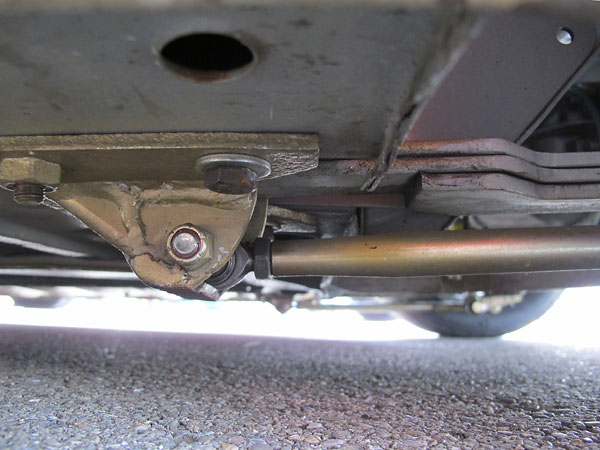
This is one of the radius rod mounting brackets.
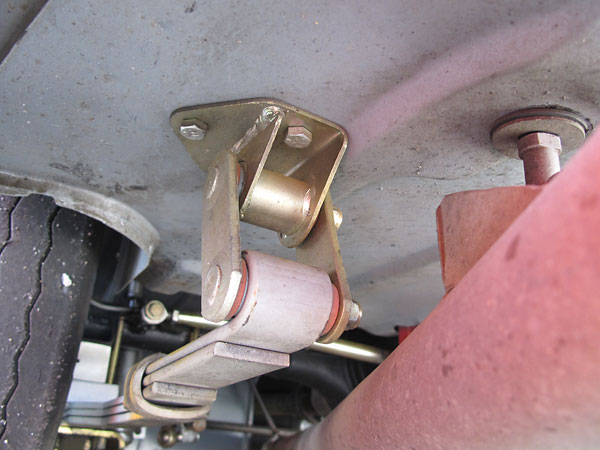
Spring shackle.
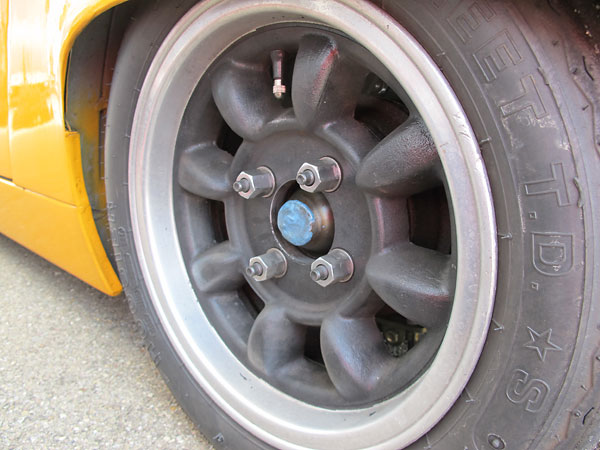
Rick is using two-piece axles. The axle shaft and the hub are connected by splines.
Blue sealant helps deter axle lube from seeping through the splined joint.
Interior
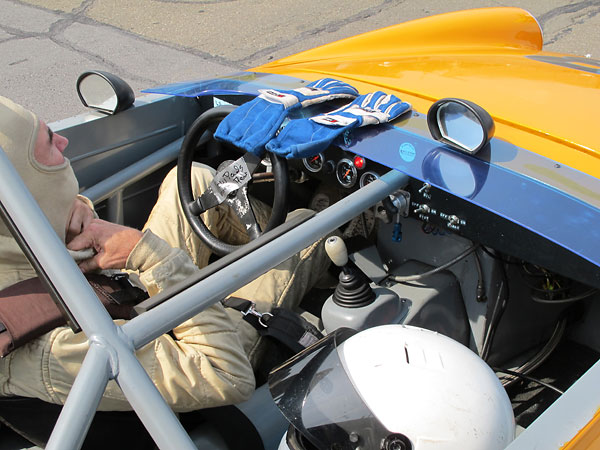
Vitaloni Sebring mirrors. Toggle switches are labeled "Oil", "Dist", and "Crank".
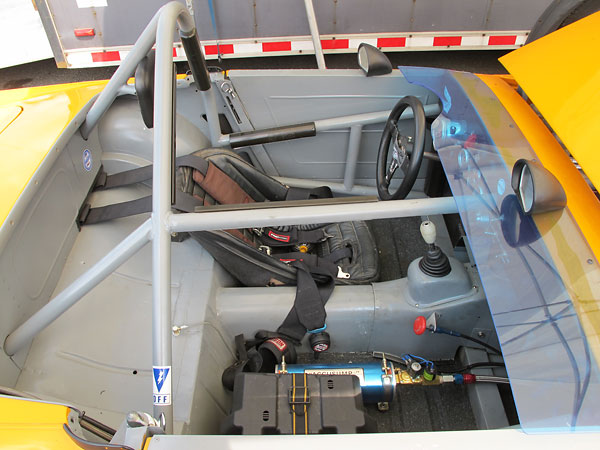
This very same fiberglass bucket seat was used by Jon Woodner at the 1971 SCCA Runoffs.
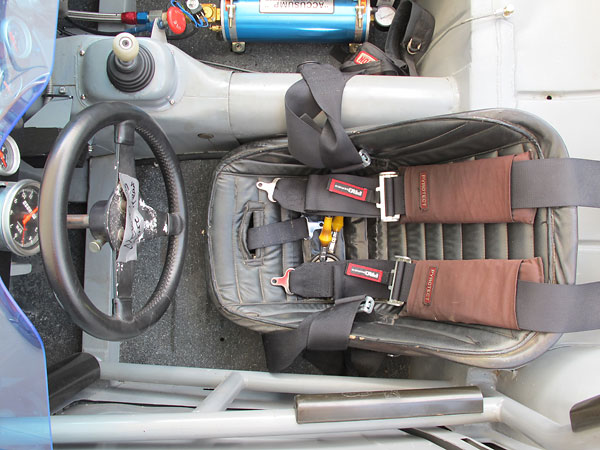
Lecarra steering wheel mounted on a quick release hub. G-Force 5-point harness (w/ Pyrotech pads).
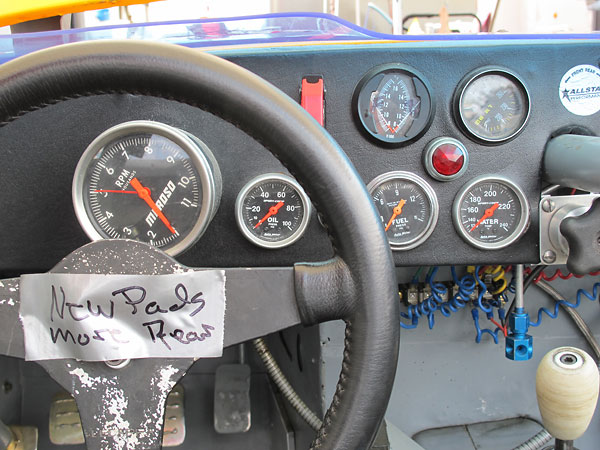
Jones / Moroso mechanical tachometer, AutoMeter Sport-Comp oil pressure gauge, Westech
dual pyrometer, Stewart Warner oil temperature gauge, low oil pressure light, AutoMeter
fuel pressure gauge, and AutoMeter Sport-Comp coolant temperature gauge.
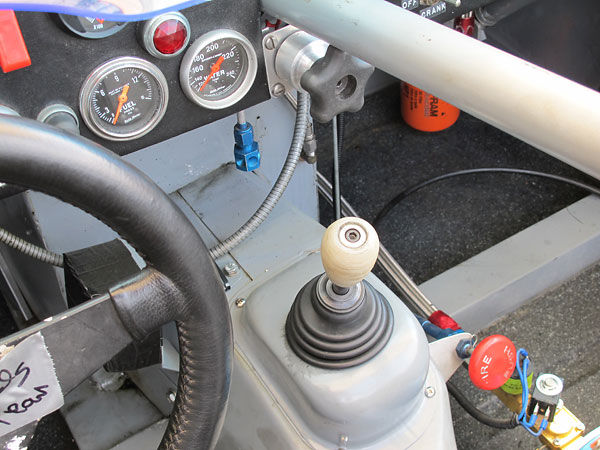
Allstar Performance remote brake bias adjuster knob.
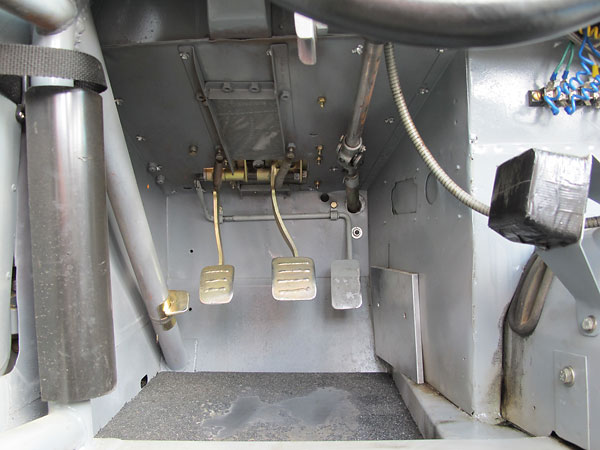
What a nifty little dead pedal!
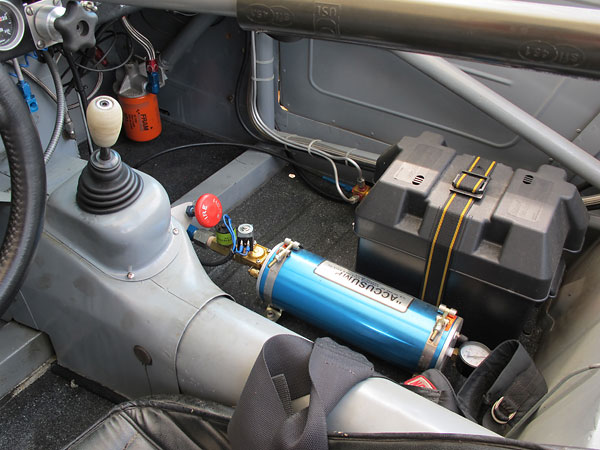
This Accusump oil accumulator is electrically actuated from a toggle switch on the dashboard.
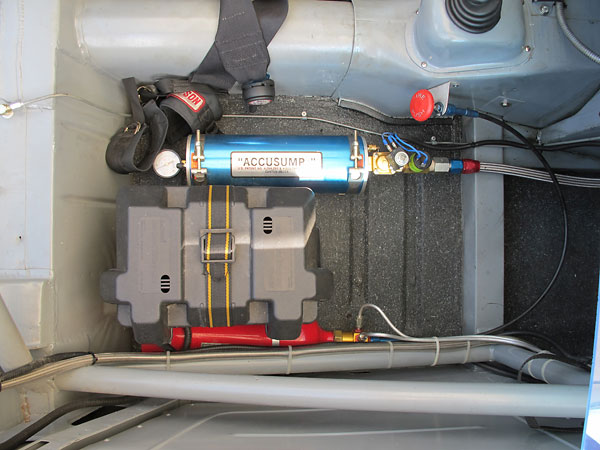
Attwood Sea Guard marine battery box. Phoenix Halon fire suppression system.
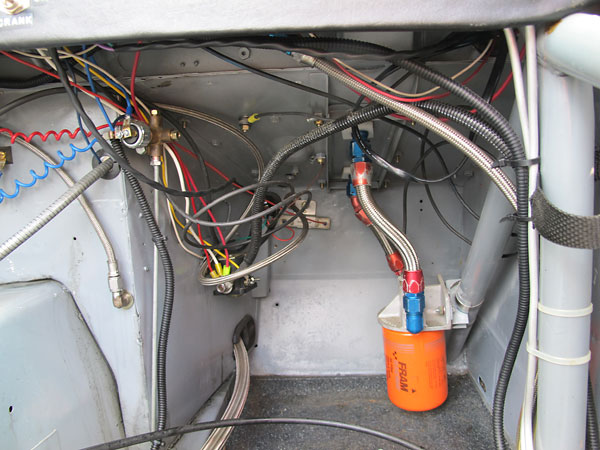
Fram Racing HP11 engine oil filter, remotely mounted.
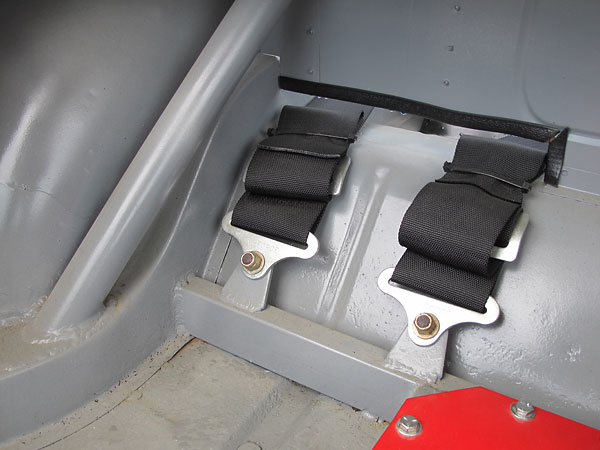
Shoulder harness attachment details.
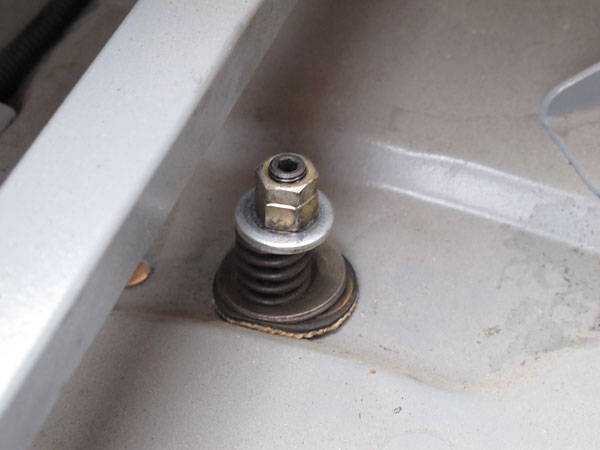
This is the spring mount at the rear of the trunk floor which supports the tailpipe.
Exterior
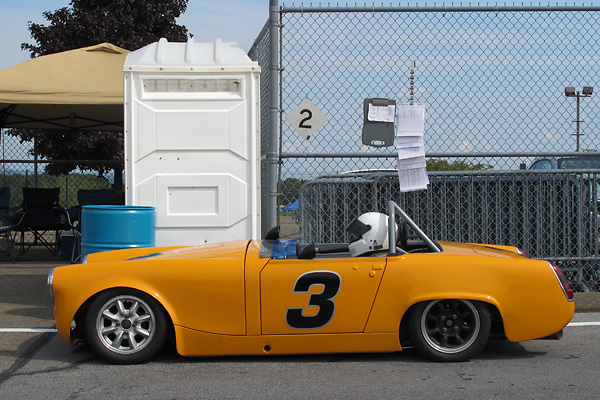
At the Sportscar Vintage Racing Association's 2012 US Vintage Grand Prix of Watkins Glen,
Rick Haynes circled the challenging 3.4 mile circuit with a very quick best lap time of
2:23.203 (85.473mph) to finish first overall in Saturday's Group 1 feature race.
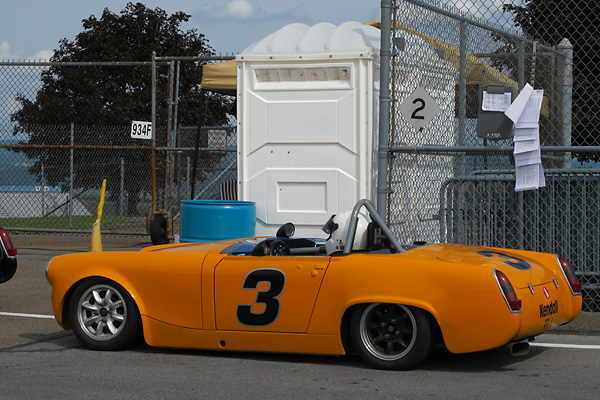
Rick Haynes won the 1985 SCCA National Championship (F-Production Class) in an MG Midget.
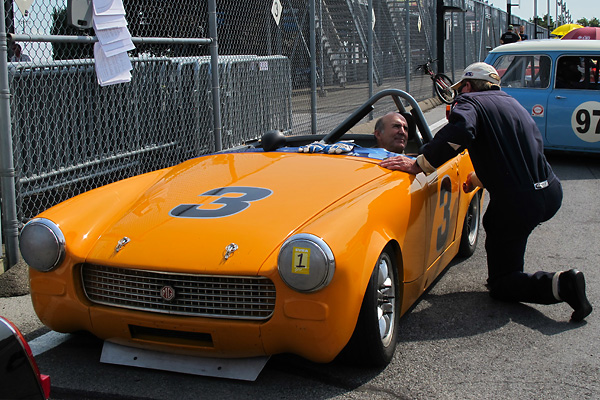
Fastest qualifier, Charlie Guest, comes back to shake hands with Rick before the race.
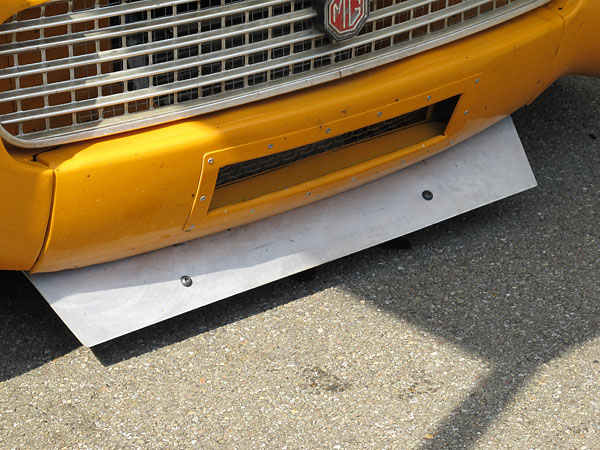
Authentic vintage-style aluminum MG Midget chin spoiler.
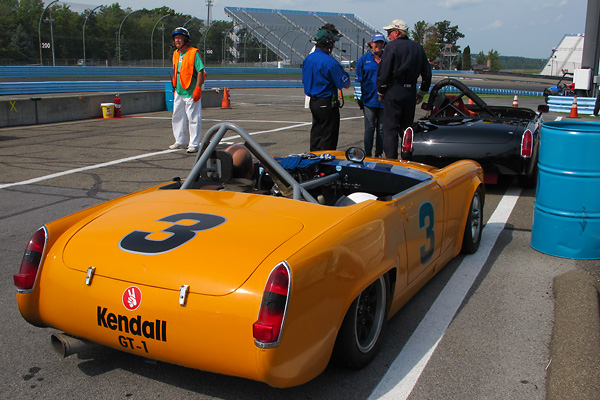
Flared fenders.
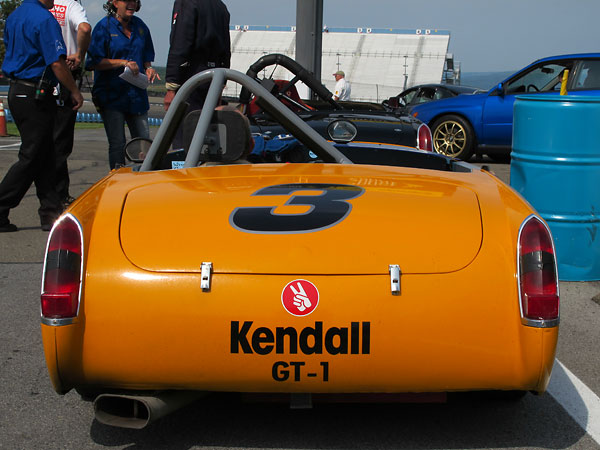
Kendall GT-1 livery. Late model Ford Mustang "Grabber Orange" paint.
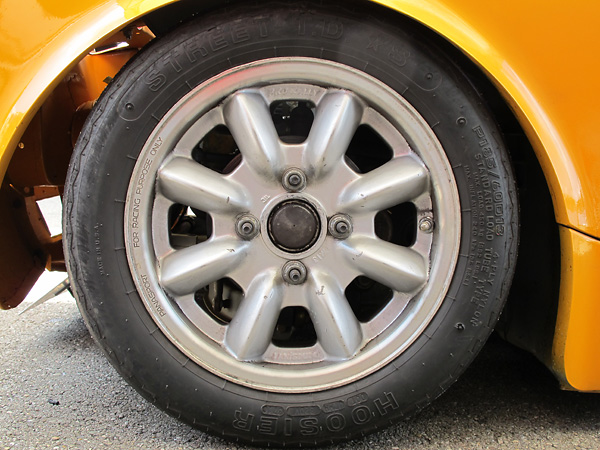
Front: Panasport Racing 13x6 aluminum wheels and Hoosier Street T.D. *S P185/60D13 racing tires.
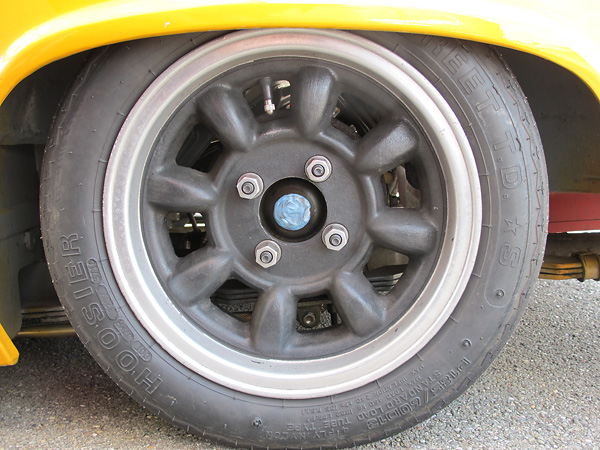
Rear: fake Minilite Sports eight-spoke wheels, probably made by Western.
Except where specifically noted above, all photos shown here are from September 2012
when we viewed the car at Glenora Winery's Vintage Grand Prix of Watkins Glen, New York.
Photos by Curtis Jacobson and Donnie Moyer for BritishRaceCar.com, copyright 2013. All rights reserved.
| Notes: | ||
| (1) |
In 1971, Jonathan Woodner qualified seventeenth and then wrecked on the race's first lap.
However, he returned to the SCCA National Championship Runoffs in 1972 to win the
F-Production championship race from pole-position. Woodner was a keen rally driver
and he piloted a variety of open wheel racecars too, progressing from Super Vees through
a variety of Formula 5000 racecars (including a McRae GM1, a Talon MR1, and a Lola T332.)
| |
| (2) |
Boss 302 Ford Mustangs which raced in the 1970 SCCA Trans Am series were actually
painted Dodge's version of "School Bus Yellow". Bud Moore quickly and unhappily chose
the color on a visit to a local paint retailer in response to a directive from Ford's
public relations department. Their concern was that Moore's preferred red, black, and
white paint scheme didn't show off cars well in black-and-white magazine photos.
Dodge's School Bus Yellow is different from Ford's production "Grabber Orange".
| |
| If you liked this article, you'll probably also enjoy these: | |||||
| Randy Byboth '64 Sprite |
 |
Derek Chima '66 MG Midget |
 |
John McCue '72 MG Midget |
|
| You're invited to discuss anything you've seen here on The British Racecar Motorsports Forum! | |||||
Notice: all the articles and almost all the photos on BritishRacecar.com are by Curtis Jacobson.
(Photos that aren't by Curtis are explicitly credited.) Reproduction without prior written permission is prohibited.
Contact us to purchase images or reproduction permission. Higher resolution images are optionally available.



